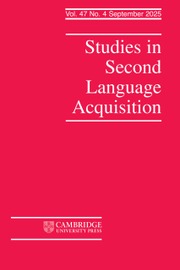Article contents
BENEFITS AND DRAWBACKS OF CONTROLLED LABORATORY STUDIES OFSECOND LANGUAGE ACQUISITION
The Keck Second Language Learning ProjectThe research presented here was supported by a grant from theWilliam M. Keck Foundation. In designing and carrying out this study, we have receivedvaluable help and advice from Michael Posner, Morti Gernsbacher, Linda Forrest, BruceMcCandliss, Paul Compton, Will Godwin, and Russel Tomlin. We also acknowledge thetechnical assistance of Ruth Rush, Marina Tackett, Shu-sen Yang, Zhu Qin, and Iaan Valentine.In addition, we thank Jan Hulstijn, Robert DeKeyser, and an anonymous reviewer for helpfulcomments on an earlier draft.The results reported in this paper come from the first author's dissertation. Anabbreviated version of portions of this paper was presented at the AILA Congress,Jyväskylä, Finland, August 6, 1996.
Published online by Cambridge University Press: 01 June 1997
Abstract
A consistent finding in second language acquisition research has been that in the early stagesof acquisition learners often receive simplified input. This finding has led researchers to questionwhether or not simplified input has a facilitative effect on the acquisition process. This studyexamines the effects of simplified input in early L2 acquisition by experimentally manipulatinglanguage input to two groups of learners and then assessing their acquisition longitudinallywithin a controlled laboratory setting. The impetus for the study described here wasGivón's (1990) competition hypothesis that posits that, in early L2 acquisition,vocabulary and grammar compete for memory, attention, and processing capacity. Because onecan communicate with vocabulary in absence of grammar but not vice versa, it was proposed thatlearners receiving pidgin input would acquire vocabulary more efficiently than learnerschallenged with the dual task of acquiring vocabulary and grammar simultaneously. Furthermore,it was hypothesized that once vocabulary processing skills were automated, learners wouldacquire grammar more rapidly. Results of a variety of measures reveal that the dual task ofacquiring vocabulary and grammar does not hinder either and that the longer the exposure togrammatical input the greater the advantage in real-time grammar processing abilities.Converging evidence from all measures of language learning provides strong support for theusefulness and viability of laboratory study of SLA.
Information
- Type
- Research Article
- Information
- Copyright
- © 1997 Cambridge University Press
- 13
- Cited by

